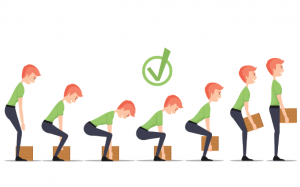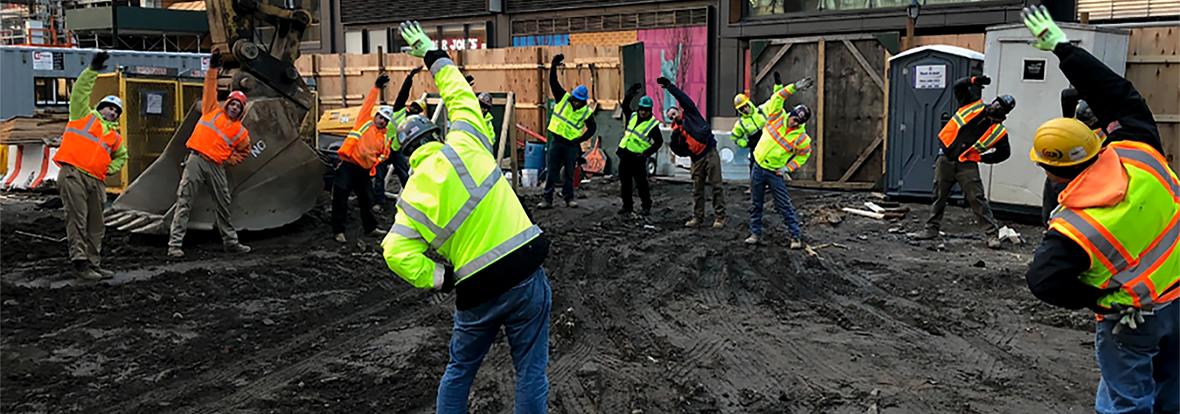Ergonomic Hazards in Construction

Ergonomics refers to creating the best atmosphere for any given occupation to prevent musculoskeletal disorders (MSDs). These disorders affect muscles, blood vessels, nerves, ligaments, and tendons in the body and can be caused by repetitive tasks, like lifting, bending, and reaching.
According to the U.S. Bureau of Labor Statistics, MSDs, or ergonomic injuries, accounted for 30% of days away from work in the United States, with construction having the fifth highest number of days away due to MSDs. These injuries can cost companies in the U.S. nearly $33 billion in workers’ compensation claims per year. With ergonomic hazard prevention, companies can reduce that risk and create a happier, healthier workforce.
What is ergonomic hazard?
Ergonomic hazard refers to conditions in a work environment that can lead to MSDs. Ergonomic hazards can exist in any workplace and can have a lasting impact on employees. These hazards can result in back pain, carpal tunnel syndrome, tendonitis, sprains and other debilitating injuries.
Ergonomic hazards can cause consistent pain to workers, who often choose to work through that pain. According to OSHA, “working hurt” is among the largest problems facing construction workers today, as working hurt can not only lower productivity, but can cause lifelong pain and disability.
Ergonomic hazard examples
Failure to recognize the safe and efficient interaction with tools and tasks in construction can lead to multiple injuries, including musculoskeletal disorders such as strains and sprains, tendonitis and lower back injuries. The number one cause of disabling injuries in construction is a back injury that occurs from an acute incident of improper lifting or improper repetitive lifting.
Let’s dive into some examples of some of the most common ergonomic hazards specific to construction sites:
Heavy lifting
It’s no secret that construction work includes a lot of heavy lifting. Lifting 50 lbs or more can be extremely tough on the body and is made tougher when the lifting is done improperly. On construction sites, workers are constantly lifting heavy equipment, lumber, metal, and are regularly opening and closing heavy container lids. These repetitive motions combined with the weight of the objects involved can create fatigue and strain that can lead to muscle tears, joint pain, and hernias.
Improper grip & repetitive hand movement
While the way you hold your equipment may not necessarily seem like it matters, improper grip on tools such as hammers, nail guns, screwdrivers, drills, and others, can cause major damage to the hand and wrist. Workers who aren’t trained to hold these instruments properly and repeatedly move their hands and wrists improperly can develop carpal tunnel syndrome, sprains, and muscle fatigue.
Tool training and upkeep
Tools are, arguably, one of the most prominent pieces of a job in construction. That being said, proper training and usage make a world of difference in the safety of constructruction teams. Additionally, keeping tools properly maintained can help reduce the muscle strain and potential joint and tendon injury that can result from tools that require extra effort.
Repetitive tasks
Projects that require repetitive motion, such as hammering, carrying and lifting materials, and even measuring, can cause pain and injury to your muscles and ligaments, especially in the hand. The longer these motions are repeated, the more wear and tear they can cause on bones, joints, ligaments, and more.
Ergonomic hazard prevention
Construction work creates a dynamic, diverse and constantly changing environment which requires the diligent protection of construction workers. While we typically focus on helping to prevent the more dramatic physical hazards posed on a construction project (such as falls from height and dropped objects), it’s important to note that less dramatic events on the job site can lead to ergonomic hazards as well. Follow these guidelines to help prevent ergonomic hazards.
- Promote correct posture that uses the legs with a straight back, and no twisting or bending over;
- Consider the overall weight and configuration of lifted items and stop to get additional assistance and use lift devices wherever possible;
- Break down heavy loads into smaller units to lighten the individual load;
- Use ergonomically-designed tools with specially-designed hand grips for repetitive tasks; and switch hands periodically as needed;
- Keep tools in top shape to avoid additional exertion when using them (e.g., sharpened knives and drill bits that are in good condition);
- Use the correct tools for the job (e.g., avoid actions such as using a screw driver rather than a knife because the tool was not easily accessible);
- Stretch to warm up before work;
- Get adequate rest; and
- Maintain proper hydration.
Whether working on site, at your desk or at home, protecting yourself from ergonomic hazards is critical to avoiding both short- and long-term health impacts. Before any task, take the time to assess your environment, identify the hazards and determine the necessary protective measures to mitigate risk. Proactive and preventative methods will ensure your immediate safety and avoid injuries.


One Reply to “Ergonomic Hazard: How It Impacts Construction Sites”
musculoskeletal pain
A simple way to remember the best practices for treating injuries is the “RICE” method. This abbreviation stands for rest, ice, compression, and elevation. When you are injured, your body needs time to properly recover. Elevating the injured area, applying ice, using compression and resting can aid in the recovery process. Learn more https://gotpainarizona.com/pain-management/pain-conditions/musculoskeletalsports-injuries/
Comments are closed.